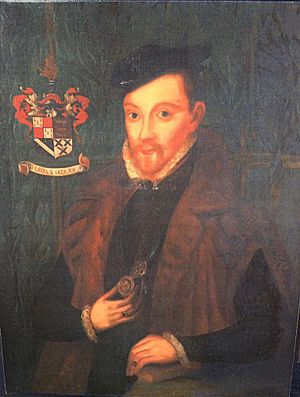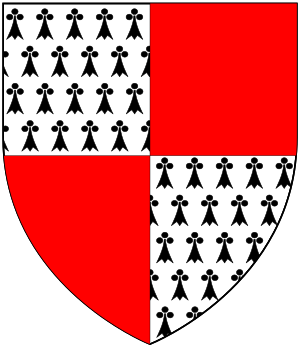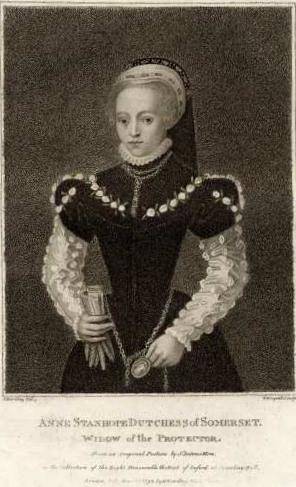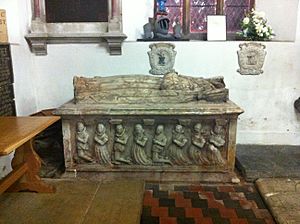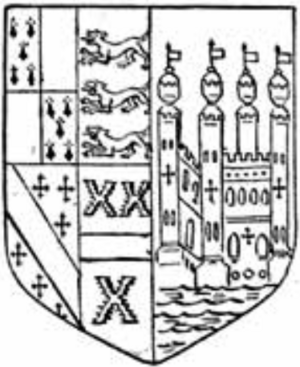Michael Stanhope (died 1552) facts for kids
Sir Michael Stanhope (born before 1508 – died 26 February 1552) from Shelford in Nottinghamshire, was an important person at the royal court. He was found guilty of planning against powerful people, including John Dudley, 1st Duke of Northumberland, and was put to death at Tower Hill.
Contents
Sir Michael Stanhope's Story
Early Life and Family
Michael Stanhope was born before 1508. He was the second son of Sir Edward Stanhope (who died in 1511) from Rampton in Nottinghamshire. His mother was Adelina Clifton. The Stanhopes were an old family from Nottinghamshire. His father, Sir Edward, was a brave soldier who fought in battles like the Battle of Stoke in 1487 and the Battle of Blackheath in 1497, where he was made a knight for his courage. He was also a trusted guard for the King and in charge of Sandal Castle.
Sir Edward Stanhope later married Elizabeth Bourchier. They had a daughter named Anne Stanhope (born around 1510). Anne was Michael Stanhope's half-sister. She married Edward Seymour, 1st Duke of Somerset, who was the older brother of Queen Jane Seymour. Queen Jane was King Henry VIII's third wife.
His Career in Royal Service
Working for King Henry VIII
In 1529, Michael Stanhope inherited some family lands after his older brother, Richard, passed away. By 1532, he was working for Thomas Manners, 1st Earl of Rutland. His half-sister, Anne Stanhope, married Edward Seymour by 1535. This connection helped Michael Stanhope join the King's service.
In October 1536, he helped stop a big protest called the Pilgrimage of Grace. As a reward, he became a Justice of the Peace for Nottinghamshire. He also got the chance to buy land from the King that became available after the monasteries were closed. He bought Shelford Priory in 1537 and later the land of Shelford in 1540.
By 1538, Stanhope worked in the royal stables. By 1540, he was one of King Henry VIII's trusted personal attendants, called Esquires of the Body.
In the early 1540s, Stanhope held several jobs in Yorkshire. By 1544, he was put in charge of the soldiers at Kingston upon Hull. This was likely thanks to his brother-in-law, Edward Seymour. His job included making sure that soldiers, food, and ships were ready for battles near the Scottish border. In 1546, he had disagreements with the people of Hull, who complained about him to the King's advisors.
Stanhope was made a knight around 1545. He was also chosen twice to be a Member of Parliament for Nottinghamshire, in 1545 and 1547.
Serving King Edward VI
In 1547, King Edward VI became king. His uncle, Edward Seymour (Stanhope's brother-in-law), became the Duke of Somerset and was made Lord Protector. This meant he ruled the country for the young King. At this time, Michael Stanhope's career was at its highest point. He became the King's Groom of the Stool, which meant he was in charge of the King's personal money. He was seen as the most important person around the King. He also became the Master of the King's hunting dogs in 1548 and a Chief Gentleman of the Privy Chamber by 1549. He bought more land that used to belong to churches.
In 1549, the Duke of Somerset lost his power. On 12 October 1549, Stanhope also lost his jobs and was sent to the Tower of London. He was ordered to be released in February 1550, but the order was quickly changed. He was later set free after promising to pay a large sum of money if he caused trouble. In 1551, he was again put in charge of Kingston upon Hull, and again had problems with the local people.
His Final Years
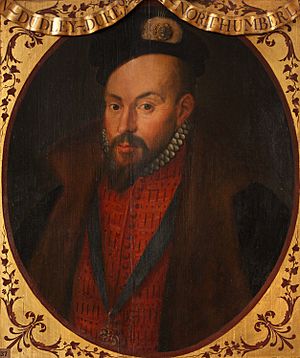
On 17 October 1551, Sir Michael Stanhope was sent back to the Tower. This time, he was accused of being part of a plot with the Duke of Somerset to harm John Dudley, 1st Duke of Northumberland and others. The Duke of Somerset was put to death on 22 January 1552. On 27 January, Stanhope was put on trial. He was accused of encouraging Somerset to rebel and planning to capture or harm important people like John Dudley.
His guilt was confirmed by a special law passed on 12 April 1552. However, when Queen Mary became queen, this decision was changed. His oldest son, Sir Thomas Stanhope, got back the family lands.
Other people accused of plotting with Stanhope, like Sir Thomas Arundell, Sir Miles Partridge, and Sir Ralph Vane, were also put to death on the same day.
Family and Children
Before November 1537, Sir Michael Stanhope married Anne Rawson (born around 1515 – died 20 February 1588). She was the daughter of Nicholas Rawson. Anne's aunt was Sir Anthony Cooke. Sir Michael and Anne had seven sons and four daughters. Their names are written on Anne's tomb in St. Peter and St. Paul's Church, Shelford:
- Sir Thomas Stanhope (1540 – 3 August 1596) from Shelford, Nottinghamshire. He was the oldest son and inherited the family lands. He married Margaret Port.
- Sir Edward Stanhope (around 1543–1603). He was a member of Queen Elizabeth I's Council of the North. He married Susan Coleshill.
- John Stanhope, 1st Baron Stanhope of Harrington. He was a high-ranking official in the royal household. King James I gave him a noble title. This title ended in 1675 when his only son died.
- Edward Stanhope (around 1546–1608). He was a Doctor of Civil Law and worked in the Court of Chancery.
- Sir Michael Stanhope from Sudbourne in Suffolk. He was one of Queen Elizabeth I's personal attendants. King James I made him a knight in 1603. He married Elizabeth Read and had two daughters. His monument is still in Sudbourne Church.
- William Stanhope, who died as a baby.
- Edward Stanhope, who also died as a baby.
- Eleanor Stanhope, who married Thomas Cooper.
- Juliana Stanhope, who married John Hotham.
- Jane Stanhope, who first married Sir Roger Townshend and then Henry Berkeley, 7th Baron Berkeley.
- Margaret Stanhope, who died as a baby.


